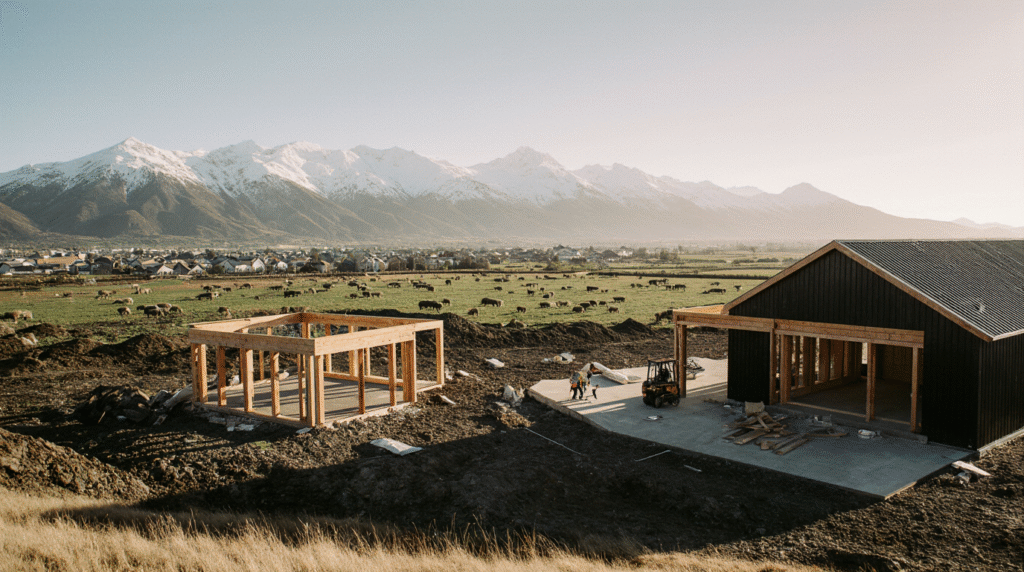Canterbury is the South Island’s sprawling heartland, a region where the mighty Southern Alps give way to the vast, fertile plains that stretch to the Pacific Ocean. While Christchurch stands as its urban hub, a quiet but powerful transformation is underway in the region’s rural and semi-rural areas. From the rolling hills of Banks Peninsula to the plains of Selwyn and Waimakariri, a new vision of construction is taking shape. It’s a vision that goes “Beyond the City,” focusing on lifestyle block builds, robust farm infrastructure, and the revitalization of smaller town developments. This shift is not just about building; it’s about a fundamental change in how people want to live, work, and connect with their land.

The Great Migration: The Rise of the Lifestyle Block
For years, the dream of owning a little slice of paradise has been a powerful force in New Zealand. Now, more than ever, that dream is driving a significant construction boom in rural Canterbury. People are moving out of the city, seeking space, privacy, and a closer connection to nature. This has led to the proliferation of lifestyle blocks, typically defined as properties ranging from 1 to 10 hectares.
Building a home on a lifestyle block presents a unique set of challenges and opportunities that differ from urban construction.
- Location, Location, Infrastructure: Unlike a city section with pre-existing services at the boundary, a lifestyle block build often requires significant investment in site infrastructure. This includes drilling bores for a water supply, installing septic tank systems for wastewater, and often, extensive earthworks for driveways and building platforms. The cost of connecting power and internet can also be a major upfront expense, sometimes requiring a greater reliance on off-grid solutions. This early-stage investment is a critical consideration for anyone embarking on a rural build.
- A Different Kind of Design: The homes themselves are often designed to take full advantage of their surroundings. Large windows, expansive decks, and north-facing living areas are common features, capturing the stunning Canterbury vistas and maximizing passive solar gain. The architectural styles often reflect the landscape, with modern interpretations of classic rural barns or contemporary designs that blend seamlessly with the environment.
- The Importance of Sheds: A house on a lifestyle block is rarely just a house. It’s an ecosystem of buildings. The quintessential shed build is a non-negotiable part of the equation. These structures are not just for storage; they serve as workshops, a place for farm vehicles, or even a home for a small business. Their construction, from simple pole sheds to complex, insulated workshops, is a major part of the rural construction market.
Also Read: Construction Costs and the Economic Outlook in 2025: A Tale of Global and Domestic Forces
Farm Infrastructure: Building for Efficiency and Sustainability
Canterbury’s economic engine has always been its agriculture. The fertile land supports a diverse range of farming operations, from vast cropping plains to burgeoning dairy farms. With a focus on sustainability and efficiency, farm infrastructure development is a key driver of the rural construction sector.
- Dairy Conversions and Infrastructure Upgrades: The ongoing shift from traditional pastoral farming to more intensive dairy operations continues to fuel construction. This involves building and upgrading dairy sheds, creating robust effluent ponds, and installing extensive new fencing and laneways. The scale of these projects can be immense, requiring specialized contractors and significant investment in new technologies to meet both productivity goals and strict environmental regulations.
- Shelter and Storage: Farmers are increasingly investing in structures that protect both their livestock and their valuable assets. Modern, purpose-built barns provide shelter for animals in harsh weather, while large storage sheds with robust flooring and ventilation systems are essential for protecting high-value crops and machinery. These aren’t just simple structures; they are often engineered to a high standard to meet specific agricultural requirements.
- Innovation in Water Management: With the region’s history of irrigation and the challenges of a changing climate, construction related to water management is a major trend. This includes the development of sophisticated irrigation systems, the construction of water storage ponds, and the use of technology to monitor and optimize water usage. Building projects in this area are critical to ensuring the long-term viability and sustainability of the region’s agricultural sector.
The Revitalisation of Small Towns
Canterbury’s smaller towns, like Darfield, Lincoln, and Rangiora, are no longer just service centers for the surrounding rural communities; they are becoming destinations in their own right. This is attracting new residents and businesses, leading to a new wave of urban-style development on a smaller scale.
- New Residential Subdivisions: The demand for housing in these towns is soaring. Developers are creating new residential subdivisions that offer a more relaxed pace of life while still providing access to essential amenities and services. The construction of these developments, including new homes, roads, and utilities, is a vital part of the regional construction market, creating a bridge between city life and rural living.
- Commercial and Community Hubs: As the population of these towns grows, so does the need for new commercial and retail spaces. The construction of new cafes, boutique shops, and small-scale professional offices is revitalising main streets. These developments are often designed with a strong focus on community, incorporating shared spaces and public amenities that foster a sense of place.
- Restoration and Adaptive Reuse: A unique and valuable trend in these towns is the restoration of heritage buildings and their adaptive reuse. Instead of demolishing old structures, developers and builders are giving them a new lease on life, transforming them into modern businesses or residential spaces. This approach not only preserves the historical character of the town but also reduces the carbon footprint associated with new construction.
Challenges and Opportunities for the Rural Builder
Building in rural Canterbury is not without its challenges. The logistics of transporting materials and equipment over long distances, the variability of ground conditions, and the need to navigate complex regional and district council regulations all require a specific set of skills and expertise. The lack of readily available infrastructure, from power connections to internet access, often means a higher degree of planning and self-sufficiency is required.
However, these challenges also present a wealth of opportunities. The demand for skilled rural builders and specialists is strong. Firms that can offer a comprehensive service from earthworks and site preparation to home building and shed construction are well-positioned for success. Furthermore, the focus on sustainability and self-sufficiency in rural builds is driving innovation, with builders and designers exploring new materials like timber and hemp, and new technologies for water and energy management.
Conclusion: A Foundation for a Resilient Future
The construction industry in rural Canterbury is a testament to the region’s resilience, adaptability, and forward-looking spirit. It’s a story that extends far beyond the cranes of Christchurch, reaching into the heart of New Zealand’s agricultural and rural communities. From the dream of a new home on a lifestyle block to the critical need for modern farm infrastructure, and the revitalization of charming small towns, construction in this region is building a foundation for a more sustainable, self-sufficient, and connected future. It’s an exciting time to be building in Aotearoa’s heartland, where the industry isn’t just constructing buildings; it’s building a new way of life.
